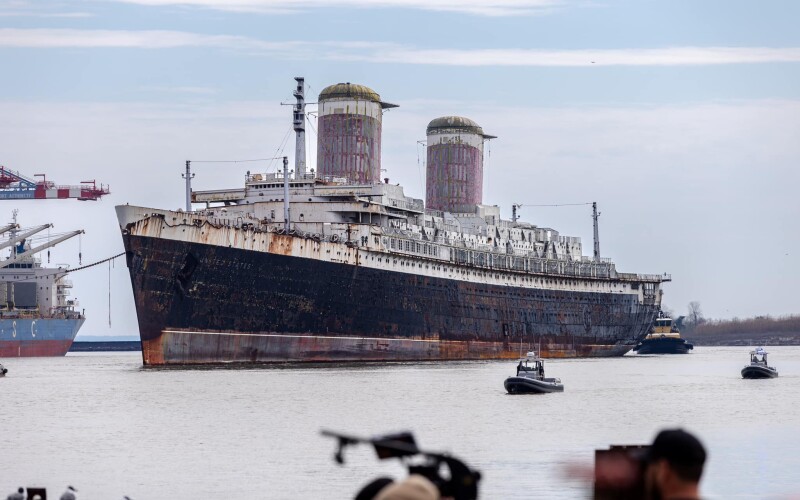After 12 days and 1,800 miles at sea, the historic liner SS United States arrived Monday in Mobile, Ala., for a year’s work of preparation before being sunk off Florida as an artificial reef.
The ship under tow by the tug Vinik No. 6 moved into the Mobile Bay approaches around 6 a.m., and by early afternoon was in port at Modern American Recycling Services. Work there – ranging from cleaning fuel tanks to saving artifacts – will get the ship ready for emplacing about 20 miles offshore of Destin-Fort Walton Beach, for what Okaloosa County tourism officials are already billing as the world’s largest recreational diving and fishing reef.
Once the pride of the U.S. maritime fleet, the 992’x101’ SS United States shattered speed records for trans-Atlantic passenger vessels during its 1952 maiden voyage, averaging 36 knots.
During its colorful career the ship was a favored ride for international travelers, and U.S. business and entertainment elites. But sea transportation rapidly lost market share to the growing airline industry, and the SS United States was retired in 1969.
Ownership passed between a series of would-be redevelopers, but various plans to revive the ship for cruising or as an in-port waterfront hotel and leisure destination fell through. In 2011, then tied up at Pier 82 in Philadelphia, the ship was purchased by the SS United States Conservancy with hopes of restoring the ship as a museum.
But again, attempts to work with partners and patrons failed over the years. In summer 2024 the conservancy faced the threat of eviction by pier owners. Okaloosa County made its play for using the deteriorating ship as an underwater attraction, a $10 million project coupled with an onshore museum telling its history.
In a statement, conservancy president Susan Gibbs noted this was the 401st voyage of what was the world’s fastest ocean liner.

“In the spirit of her record-breaking history, America’s Flagship concluded her journey from Philadelphia to Mobile faster than anticipated,” said Gibbs. “As she moved through the waves for the first time in 28 years, countless onlookers and admirers along the country’s eastern seaboard were inspired by her majesty and beauty.”
“Now, as she prepares for her next chapter, the SS United States Conservancy, together with Florida’s Okaloosa County, will advance the design and development of a dynamic and immersive museum and visitor’s center that will celebrate the ship’s place in American history.”
Preliminary renderings of the planned museum showed it may include one of the SS United States’ distinctive ‘winged’ funnels.




